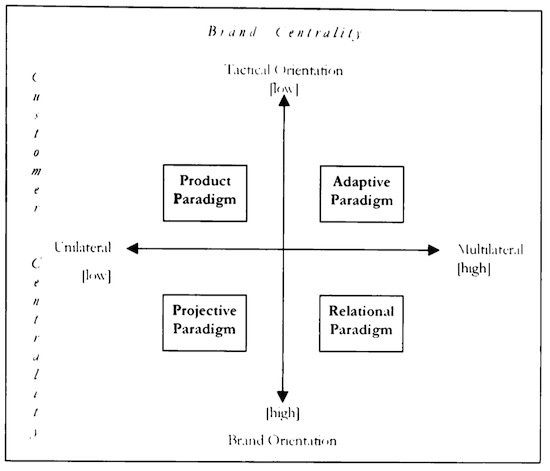This post is part of my bachelor paper ‘The Evolving Role of Creativity in Brand Management’. You can see the other posts and the table of contents here.
The adaptive paradigm changes its focus on the “output” perspective and comprises a range of consumer-centred brand definitions, the most notable of those definitions being the brand image concept (Louro & Cunha 2001, p.863), as defined earlier as “perceptions about a brand as reflected by the brand associations held in consumer memory” (Keller 1993, S.3). In this more consumer-centred conceptualization of brands,
“[b]rand management is enacted as a tactical process of cyclical adaptation to consumers’ representations of the focal brand whereby brand image gradually supplants brand identity (Aaker 1996). Within the adaptive view, brand image becomes the core theme underlying strategic formation and frames the specification of a brand’s elements and its supporting marketing program (Kapferer 1992).” (Louro & Cunha 2001, p.863)
With performance measures usually focused on consumer-based metrics and brand management generating value by adapting to a particular competitive context, brand management needs to develop superior “outside-in capabilities” (Day 1994 qtd. in Louro & Cunha 2001, p. 864) developing “[…] the ability of the firm to learn about customers, competitors and channel members in order to continuously sense and act on events and trends in present and prospective markets.” (Day 1994, p.43 qtd. in Louro & Cunha 2001, p. 863)
The adaptive paradigm in turn is criticised mostly by the brand identity school which argues for the importance of a companies guiding mission, culture and brand essence and against the “recursive reconfiguration of a brand’s identity in response to incremental changes in consumer’s expectations” (Louro & Cunha 2001, p.865).
Next up is the relational paradigm and a summary perspective.
—
Day, G.S., 1994. The capabilities of market-driven organizations. Journal of Marketing, 58(4), pp.37–52.
Louro, M.J. & Cunha, P.V., 2001. Brand management paradigms. Journal of Marketing Management, 17(7), pp.849–875.


